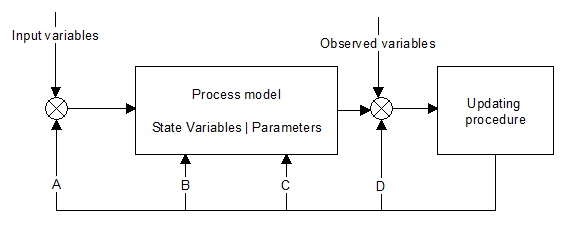HEPEX-SIP Topic: Hydrologic data assimilation (1/2)
Contributed by Albrecht Weerts, Liu Yuqiong and Hamid Moradkhani
What is hydrologic data assimilation?
Data assimilation is the process in which model and measurements are combined to provide, in the context of HEPEX, more accurate and reliable forecasts. The term data assimilation includes model calibration, input, state & parameter updating and postprocessing (‘output updating’). Statistical postprocessing (as defined in the HEPEX SIP Topic Postprocessing) could be viewed as a special case of data assimilation. The figure below gives a general idea about the different updating schemes used in hydrologic forecasting.

Schematic display of different data assimilation schemes (from Refgaards, 1997)
State updating aims at updating (improving) the model state (in simulation mode) on the fly based on available observations. In forecast mode, the improved estimate of the model state should result in more accurate and reliable forecasts. The most direct form of assimilating data into a model in operational hydrologic forecasting is the manual correction of the internal model states of the model by human forecasters based on their expert interpretation of the discrepancy between the recent model simulations and the observations (Liu et al., 2012). Parameter updating, which is also practiced in operational hydrological forecasting (e.g. by NWS via MODS), aims at improving the parameterization of the model in real-time (in contrast to model calibration, which is normally done offline).
Updating like postprocessing is also intrinsically related to forecast verification: feedback from verification allows the forecaster to target the assumptions how model and measurements should be combined and to evaluate the performance of different updating algorithms, or use of different (types) of measurements or assumptions about the errors (model, measurements), etc.
Data assimilation is one of HEPEX six major themes
Two HEPEX special data assimilation topics workshops were held: the first in 2010 in Delft, The Netherlands, co-organized by NOAA-NWS and Deltares, and the second in Seoul, Republic of Korea, organized by NIER, in 2012, to promote scientific exchanges and discussions on the topic within the scientific and user community. It is likely that a third topical workshop will be organized in 2014 in Texas, USA, together with the CAHMDA workshop.
One of the outcomes of the 2012 workshop is to launch a data assimilation intercomparison somewhere in fall of 2013, with several testbed locations across the globe (e.g. Germany, USA, Korea, Taiwan, etc.). The idea is that results will be reported on the third topical workshop in Texas (details will follow).
What can we find about data assimilation for hydrological prediction in the literature?
The joint open access paper below, a result from the first topical HEPEX DA workshop, provides a recent overview of the past and more recent literature:
Advancing data assimilation in operational hydrologic forecasting: progresses, challenges, and emerging opportunities. Y. Liu, A.H. Weerts, M. Clark, H.-J. Hendricks Franssen, S. Kumar, H. Moradkhani, D.-J. Seo, D. Schwanenberg, P.J. Smith, A.I.J.M van Dijk, N. van Velzen, M. He, H. Lee, S. J. Noh, O. Rakovec, and P. Restrepo, Hydrol. Earth Syst. Sci., 16, 3863–3887, doi:10.5194/hess-16-3863-2012.
This post is a contribution to the new HEPEX Science and Implementation Plan.
See also in “HEPEX SIP Topic: Hydrologic data assimilation”:
0 comments